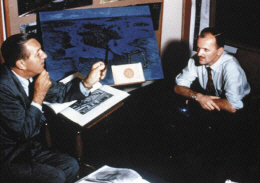 |
| Peter Ellenshaw (1913-2007) |
Above, we see Huntingdon Manor magically emerge from a drawing to 'reality' from the opening scene of Walt Disney's Story of Robin Hood and his Merrie Men (1952). Later, there are some stunning views of Nottingham Castle from the archery contest, Sherwood Forest, and much more. But how was it done?
 |
| Nottingham's Archery Contest |
One of the many elements that gave Disney's live-action film such a sumptuous quality was the matte effects of Peter Ellenshaw (1913-2007).
In the days before CGI, filmmakers relied on ‘matte painting’ as a cost-effective substitute for building sets or filming on location. Matte paintings were created by artists using paints or pastels on large sheets of glass or integrated with the live-action footage via double exposure.
 |
| A camera set up for a matte shot |
Its foremost practitioner was Peter Ellenshaw, who joined Denham Studios in 1935 as an uncredited assistant to his stepfather, W. Percy Day, the inventor of matte painting on such things as Things To Come (1936) and The Thief Of Bagdad (1940).
In 1947, he created the wonderful mountain scenery for Michael Powell’s and Emeric Pressburger’s Black Narcissus. Martin Scorsese, a big fan, said that watching it was ‘like being bathed in colour.’
After Black Narcissus, Ellenshaw worked on over 30 films for Walt Disney Studios. He began working as a freelancer for Walt Disney in 1947 and became involved in making Treasure Island, the studio's first live-action movie. The great art director Carmen Dillon recommended Peter’s work to Walt for his next project in England, The Story of Robin Hood and his Merrie Men in 1952.
 |
| The Earl of Huntingdon rides to Nottingham Castle |
Above, we see Ellenshaw's beautiful artwork on glass in the scene where the Earl of Huntingdon approaches Nottingham Castle. Below, we see the original scene as the riders approach the hill before Ellenshaw applies his masterful brushwork.
Ellenshaw did fifty-two matte paintings for The Story of Robin Hood.
 |
| The riders approach the hill before the painted castle |






























